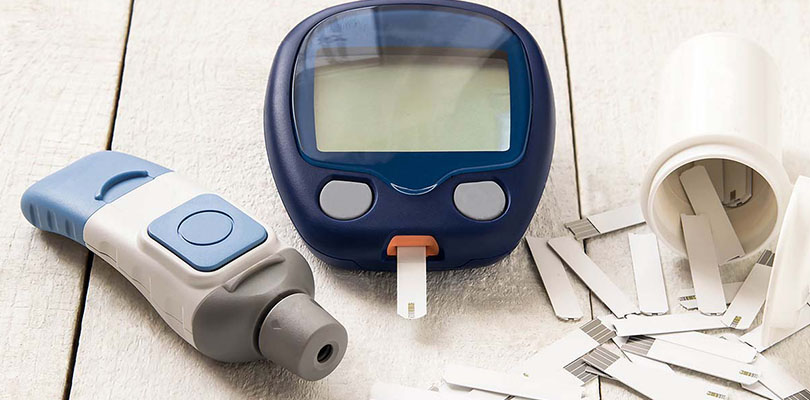Types of Glucose Meters: Choosing the Right Glucose Meter for You
If you have been diagnosed with diabetes, it is important that you check your glucose levels regularly. This will not only help to prevent hypos but can also protect you from developing serious complications in the future.
Uncontrolled blood glucose can lead to many chronic conditions including:
- Kidney disease
- Heart disease
- Stroke
- Nerve damage
- Retinal disease
- Blindness
Regular testing can keep you on top of your blood glucose, reducing the risk of these diseases. It can also help you to make good dietary choices and ensure that your medication is at the correct dosage.
Luckily, testing your own glucose levels at home is easy to do. However, with such a wide range of glucose meters on the market, choosing the right one can be confusing.
In this article, we will discuss the different types of glucose meter available, plus some extra things to consider when buying.
Types of Glucose Meter
There are two main types of glucose meter; self-monitoring glucose meters and continuous glucose meters.
Self-Monitoring Glucose Meters
The self-monitoring glucose meters are the most common by far. They are readily available and give fast results, making them very convenient to use.
To use a self-monitoring glucose meter you need to use a small needle called a lancet to prick your skin, usually on a fingertip. This lancet is loaded into a device known as a pen which makes the whole process easier and keeps pain to a minimum.
Once you have pricked the skin, a few drops of blood are placed directly onto a test strip and loaded into the machine. You will have your result after just a few seconds.
Pros of Self-Monitoring Glucose Meters:
- Available over-the-counter
- Relatively low initial cost
- Portable
- Quick
- Easy to use
Cons of Self-Monitoring Glucose Meters:
- Repeated finger-pricking can be painful
- Cost of replacement lancets/test strips can be high
- Accuracy is affected by external factors
Continuous Glucose Meters
Continuous glucose meters can be implanted under your skin to give automatic readings every few minutes. They reduce the need for skin pricking, although they do not eliminate it completely.
This is because you will still need to use blood samples to calibrate the machine occasionally. You will also still need to test your blood if you are thinking about increasing your insulin dose or treating a hypo.
The real advantage of continuous glucose meters is that you get a complete picture of your glucose levels over the course of an entire day – even at times you would not normally be able to test.
However, most people do not need such a high level of monitoring, and continuous glucose meters are usually reserved for people at higher risk of hypos.
Pros of Continuous Glucose Meters:
- Gives readings over a 24 hour period
- No finger pricking needed to test
Cons of Continuous Glucose Meters:
- The device must be implanted under the skin
- Not available over-the-counter
- Occasional finger pricking still required for calibration
There are many lifestyle factors to be considered when trying to manage your blood sugar. Here are some healthy habits that diabetics should adopt.
A New Type of Glucose Meter?
A new, non-invasive type of glucose meter is also in development. It will use low-power radio waves to detect glucose levels in the blood. This will reduce the need for finger pricking and make glucose testing more comfortable and convenient.
However, it is not yet available to the general public, and it is unclear when it will arrive on the market.
Things to Consider when Choosing a Glucose Meter
When choosing a glucose meter, there are many different factors to consider. Many of them come down to personal preference, but there are some key features which are worth considering before you buy.
Cost
One of the primary considerations when choosing a glucose meter is cost. As well as the initial cost, you should check the price of replacement lancets and test strips. Many glucose meters are cheap to buy initially, but if you aren’t careful, the cost of replacement equipment can soon stack up!
Convenience
You will want a machine that is simple and convenient to use. Things to consider are the size of the device itself, whether you need to place it on a surface or can use it on the go, and the size of the display.
If you have problems such as retinopathy, opt for a machine with an easy to read display. Some glucose meters even have a verbal function which is great if you struggle to see clearly.
Accuracy
The accuracy of glucose meters can be affected by various factors. Dirt, extreme heat and humidity can all affect the way your meter works.
In addition, some meters will not work if not enough blood is used. This is why it is important to calibrate your meter regularly to ensure that you are getting accurate readings.
Some older meters need to be calibrated with a code every time you start a new batch of test strips. This has been eliminated in newer models, and accuracy testing can be done monthly using a control solution.
If you find it hard to get enough blood from a finger prick, opt for a meter which requires a smaller sample to work accurately.
Tracking
Tracking your glucose levels over time is very useful, and many glucose meters have features to make this easier. Some link to a smartphone app, allowing you to save previous readings and take the average over the course of a week or month.
You may also be able to tag events such as a large meal or a trip to the gym. Some meters even upload this information automatically, via Bluetooth.
Other features
Another feature you might want to consider is whether the glucose meter has alarms, reminding you when it’s time to test. If you have type 1 diabetes, you will also want to check whether your meter tests for ketones too.
Finally, make sure that your chosen meter has a warranty and read it carefully. This will ensure that if your meter breaks within the warranty period, you will be able to have it fixed or replaced without extra fees.







